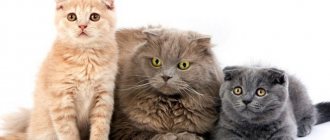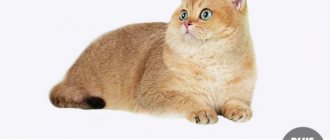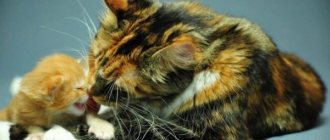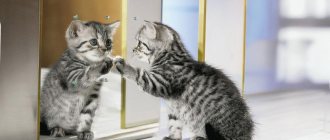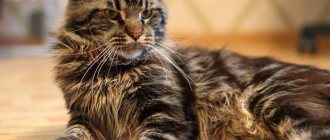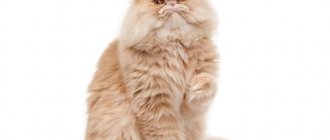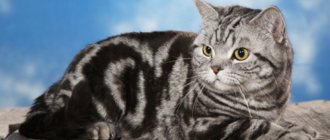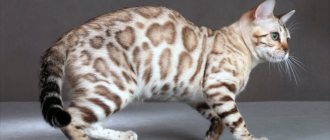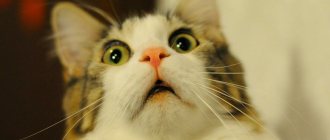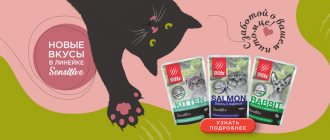What is ticking?
Cats with fur of this color really look very attractive and unusual. The fur coat of such pets does not have the usual stripes and at the same time it does not look monochromatic.
The ticked color of cats is also called “color without color.” In this case, the stripes are not located directly on the animal’s body, but on each individual hair. A cat with such fur looks as if covered with freckles. When such an animal moves, its fur seems to shimmer and shine. Many people believe that this coloring is very similar to the colors of squirrels or chinchillas.
Why is Whiskas the cat so popular?
Not all people are loyal to advertising on television or on the Internet. But, whatever one may say, it has become an integral part of the life of a modern person. Advertising is a time when the human brain perceives information primarily superficially, that is, literally lets it pass by.
Many people like the cat from popular advertising
But who doesn’t stop their gaze on the screen when the face of everyone’s favorite animal appears there? This adorable cat from a cat food commercial has won the hearts of viewers. Its characteristic, memorable color has long branded all cats of this breed as the “Whiskas cat.”
Cat breed from Whiskas food advertisement
When a person who is just thinking about what breed of kitten to get, he involuntarily pays attention to the options that are most accessible to the eye. Today these are animals from commercials. Then many people have a question about the breed of cat from Whiskas. The Whiskas cat is a British Shorthair breed.
Note! The color of the kitten in the advertisement is called silver tabby, and today this color is the most popular among British Shorthair cats. Perhaps this was facilitated by the extensive advertising of Whiskas with a cat of this breed in the leading role.
Main characteristics of color
A cat's coat can only be recognized as ticked if:
- there is no extraneous pattern at all on the animal’s body, neither clear nor blurred;
- On each hair on the animal’s fur there are several dark and light stripes (at least 3 dark stripes).
The ticked color of cats, among other things, allows for stripes on the tip of the tail and paws, the presence of a “necklace” on the neck, as well as stripes in the shape of the letter “M” on the forehead. Such drawings are not considered a reason for disqualifying cats of any breed except Abyssinian.
Color points
The name of the suit is translated from English as: “color” + “point”. The body of a color point cat is white, cream, or ivory. And only the “mask” on the face, ears, tail and legs are darker in color. Depending on its tonality, there are:
- seal points (black dots);
- tabby points (striped points);
- lilac points (lavender, lilac points);
- cake points (tortoiseshell points - a combination of cream and red spots);
- blue points (blue, silver dots);
- cream points (cream points);
- Choclete points (brown, chocolate points).
The formation of the point color is interesting: a special gene causes the coat to darken only in certain areas of the body - the coldest ones. This is just the muzzle, ears, paws and tail.
Photos of color point suit owners:
Types of ticked cat colors
In addition to Abyssinians, cats of the following breeds can have such coat colors today:
- Scottish and British;
- American Wirehair, Miniature, Shorthair;
- bobtail;
- American Curl;
- Persian;
- Maine Coon;
- Ceylonese;
- Devon Rex;
- munchkin and some others.
There are 9 main types of ticked colors in cats:
- black;
- cream;
- blue;
- chocolate;
- cinnamon;
- red;
- lilac;
- gold;
- faun.
Solid
This coat coloring is also called plain, solid. The main feature is that the coat is uniformly colored in one color, without even the slightest inclusions of a different tone. The color is equally saturated along the entire length of the hair.
Solid suits of the “Scots”:
- blue (gray-silver);
- ebony (all black);
- red (red);
- white;
- cream;
- chocolate (rich brown color);
- cinnamon (cinnamon tones);
- lilac (beige with a lilac, pinkish tint);
- “fauns” (beige, piebald).
The most classic color for Scottish cats is blue.
Photos of Scottish cats of solid colors:
Black ticked color
The coding for this color is as follows: n 25. Cats with this color have a black pattern on a copper background. The nose and eyes of animals are surrounded by a rim. The color of this edging is dark. Cats have a brick red nose and eyes that can be any color, including green. Pets with such fur do not have only blue eyes. The paw pads of black ticked animals are brown or black as standard.
How to choose a Scottish Straight kitten
It is best to buy a Scottish Straight from a nursery, since only they can guarantee that you will purchase a purebred kitten.
Kittens are handed over to new owners at the age of 2-3 months. By this time, they are already accustomed to the tray, vaccinated and have all the necessary documents.
It is better to buy kittens from professional breeders so as not to run into a barn cat
To increase your chances of purchasing a healthy purebred pet, it is advisable to meet the breeder in person and observe the kitten. The baby should be active and cheerful. His tummy should be soft, not bloated, but not sunken. It should have plush soft fur. Bald spots or wounds on the skin are not allowed.
It is necessary to examine the kitten's nose, eyes and ears. There should be no mucus or crusts on them.
Red ticked
The coat of d 25 cats not only looks unusual due to the ticking, but is also very bright. The pattern on the body of such animals is deep red on a red background. The nose and mouth of ticked cats of this color are also surrounded by a rim of the same color.
The eyes of animals in this group can range in color from yellow to brown. The nose and paw pads are brick red.
Plain (solid)
The color of Scottish Fold cats is monochromatic and they should not have any other color. The fold-eared cat can be of the following colors: white and black, chocolate and lilac, blue and red, cream, fawn and cinnamon. The most popular color in the world among solid Scottish cats is blue. These are the majority of cats.
White
The white Scottish Straight cat can have different eyes, from blue and bright orange to rich amber and copper. Kittens of this variety remain white for the rest of their lives. If kittens have spots, then an adult cat remains white for the rest of its life.
Black
The Scottish Fold black cat is mostly bright in color. A couple of white hairs are acceptable, but if the cat has large red and brown patches, then it is not a purebred.
Black Scottish Fold cats should be bright black in color and their ears, like all fold-eared cats, should be pressed to the head, unlike straight-eared cats. A straight-eared black cat always has its ears erect.
Chocolate
The chocolate Scottish Fold looks impressive. The chocolate color is quite rare. Brown fold kittens should have a smooth, uniform coat of chocolate color. The dark brown coloring adds nobility to the cat.
A brown cat gets this color if he has chocolate, chocolate bicolor or chocolate color points in his pedigree. Chocolate Scottish kittens always delight their owners. They look very cool against a light background.
Lilac (lavender)
A lilac long-eared cat gets this color if he has either lilac color points or lilac in his pedigree. The lilac coloration goes well with orange, copper or amber colored eyes and a light brown nose. This color is also called coffee with milk.
Blue color (blue)
The Scots Blue can have a coat color of many shades of blue. Some cats may have a fur color closer to gray, and some closer to blue. Each hair must be saturated, then the coat will be perfectly blue.
Gold
This is the rarest and very beautiful color of cats with the coding ny 25. The background of the animals’ fur in this case is apricot, and the stripes on the hair are dark. The most common golden ticked color is found in British cats. According to the standard, the eyes of such pets should be emerald green. The paw pads, as well as the outline of animals in this group, are brown or black. The nose of cats of this color is brick-red.
Varieties of tabby pattern
Tabbed patterns are divided into 4 types, each of which contains its own genetic information.
The main ones:
- classic (marble);
- ticked (Abyssinian);
- striped (mackerel);
- spotted (leopard).
All other types of colors are mixed and combined with other colors.
Classic (Marble)
You can recognize a marbled cat by its large spots, wide stripes and interesting curls located on the back and sides. The area around the neck and paws is decorated with subtle graphic designs. This suit is the most beautiful and classic.
Ticked (Abyssinian)
Most often, cats of the Abyssinian breed have a ticked appearance, which is why this specimen is also nicknamed Abyssinian. Outwardly, it seems that there are no extra patterns on the animal’s fur other than a solid color.
Be sure to read:
Colors of Scottish cats: description, features, rare colors of folds
In fact, it is covered with stripes, lines, and small dots that are barely visible. They can be seen if you look closely. The pattern is located on the chest, limbs, tail and face of the cat, several tones darker than the main shade.
Striped
With a striped (tiger) pattern, the animal's fur is covered with vertical narrow lines running along the spine and spreading throughout the body. From the top point, the pattern diverges to the sides and branches.
The color of the tiger stripes stands out against the general background in contrast. This color is also called mackerel after the striped mackerel fish.
Spotted
Felinologists also call the spotted type of coloring leopard. The coloring is characterized by patterns that consist of spots and specks.
A drawing of a relatively dominant color may be bright or not very different in tone from the base. An animal with this pattern looks like a small leopard.
Blue wool
Such cats, belonging to group a 25, have fur of a warm beige background with blue ticking. The nose and eyes of these animals are outlined with a grayish rim. The paw pads of blue cats are deep pink. The nose is the color of a withered rose. These cats have yellow eyes.
Nutrition and care
Despite the fact that adults of this cat breed are calm and lazy, at a young age they need to be carefully monitored, since Scottish Fold kittens are energetic, restless and playful.
For this reason, you need to hide in advance various kinds of wires and fragile objects that the kitten may like. When choosing bowls for feeding, preference should be given to heavy containers so that the baby cannot knock them over. It is worth taking care of a place to relieve its natural needs, so that from the first days the pet learns to go to the toilet only there.
You need to find a place in the house for your pet to rest and equip it with a house or bedding in advance. You also need to buy a scratching post or make one yourself. To do this, wrap a thick rope tightly around the table leg.
Like any child, Scottish Fold kittens are very playful, so you need to buy them several different toys, otherwise these toys may become the owners' clothes or shoes.
Caring for this breed of cat is about the same as caring for any other cat. At least once every 1-2 weeks you need to comb his fur, for which you need to buy a special brush designed specifically for this. When bathing (about once every 6 months), under no circumstances should water get into your ears.
Once every two weeks, you need to clean your cat's ears using a rolled-up cotton pad. Using special scissors for trimming your pet's nails, you should shorten their length at least once a month. Deworming should be carried out once every three months, and fleas should be driven away in early spring.
It is worth keeping an eye on the animal's eyes: if they begin to turn sour, you need to wipe them with a cotton pad dipped in brewed strong black tea. If the eye condition does not improve within a week, you should take your pet to the veterinarian.
Scottish Fold blue cats are prone to gaining excess weight. To keep your pet healthy, you need to take its diet seriously. Representatives of this breed can be fed with premium-class dry food from a trusted manufacturer. Pet stores sell food specialized for a specific breed of cat. They contain all the microelements necessary for the full development and functioning of a pet.
Also suitable are boiled chicken offal, boiled sea fish, eggs, kefir, fermented baked milk, vitamin complexes (after consultation with a veterinarian).
For those who have decided to purchase a Scottish Fold blue cat kitten, it is necessary to contact only trusted breeders who will be able to provide all the documents of the kitten’s parents, including vaccinations.
Additional characteristics about the Scottish Fold blue cat can be found in the video below.
Secrets of genetics
Breeders consider breeding ticked cats to be a difficult task, but at the same time very exciting. At the moment, experts have been able to identify only two genes responsible for this design of the fur of furry pets: Abyssinian and common ticking.
The first gene gives the animal's hairs ticking with the same frequency of stripes. In this case, coloring with triple zoning is considered ideal. Mandatory for such an exterior is, among other things, a stripe on the back of a slightly darker shade than the body color.
The general ticking gene does not give the number of stripes on the hairs and their distribution, but simply smoothes out the saturation in the cat’s color. The homozygous form of this U gene is capable of making the pattern on the animal’s body almost invisible. In a heterozygous one, a clear pattern is observed on the paws and tail, as well as a shadow pattern on the body. This gene has the peculiarity that it begins its work from the very birth of the kitten.
Where to buy the kitten from the Whiskas advertisement
Whiskas for kittens: dry and wet food for cats
Today, buying a cat as advertised is not a big problem. Advertising contributed to the popularization of the breed. It is noteworthy that kittens of different breeds took part in various videos. So, for example, when buying a kitten from a Whiskas advertisement, you can choose from British, Scottish, American and European shorthairs. Outwardly, they are not much different from each other and will become family favorites for many years.
List of some popular nurseries engaged in breeding cats of these breeds:
- Al Blues (St. Petersburg);
- Allure (St. Petersburg);
- Hope Island (St. Petersburg);
- Sandi-Cat (St. Petersburg);
- Astropuss (Moscow);
- Britanic (Moscow);
- Brittish House (Moscow).
British Shorthair kittens are the most popular among breeders
Bicolors
The coat color of these beautiful creatures has two colors, and a combination of white and any other shade is mandatory. Purebred bicolors must have a white belly, neck, chest, chin, limbs and, of course, muzzle.
Pets © 2021 Attention! The information published on the site is for informational purposes only and does not constitute a recommendation for use.
Source
| Code | Decoding the code |
| a | blue |
| b | chocolate |
| c | lavender |
| d | red |
| e | cream |
| f | tortoiseshell (black) |
| g | tortoiseshell (blue) |
| h | tortoiseshell (chocolate) |
| j | tortoiseshell (lilac) |
| m | caramel |
| n | ebony |
| o | honey |
| p | beige |
| s | silver |
| t | amber |
| w | white |
| y | gold |
| X | unregistered color |
Content Features
Plush pets, like any cats, require proper care and proper nutrition. Before bringing home a Scottish kitten, the owner must purchase the following supplies for it:
- a small tray with low sides;
- bedding made from natural materials;
- scratching post;
- hypoallergenic toy.
It is necessary to begin raising an animal from the first days of the appearance of this fluffy ball in the house. Scottish cats are considered ideal pets. They easily make contact with all family members, having a special sympathy for small household members. Cats prefer sleep to active games. They are very attached to their owner and love to sit on his lap for hours.
The pet's sleeping place should not be located near a window or on the aisle. The Scots love warmth and comfort. They also do not like long walks in open areas. This breed is prone to being a homebody. For cats, various structures, such as stairs or shelves, are of great interest.
Scottish cats eat premium or super-premium food. They are highly digestible and rich in vitamins and minerals essential for cats. Natural foods are also suitable for Scots: lean meat, cereals, boiled fish and vegetables. The diet of kittens should be varied. And at the same time, babies should not be overfed. An overweight animal begins to move little and subsequently acquires a number of dangerous diseases.
Cats with short hair are brushed no more than once a week. This procedure is carried out using special brushes and combs. Bathe your pet as needed, and keep your ears and eyes clean every day. Scottish kittens are characterized by increased lacrimation, so the owner needs to stock up on special drops from the pet store.
The following video will tell you how to choose a healthy Scottish kitten.


